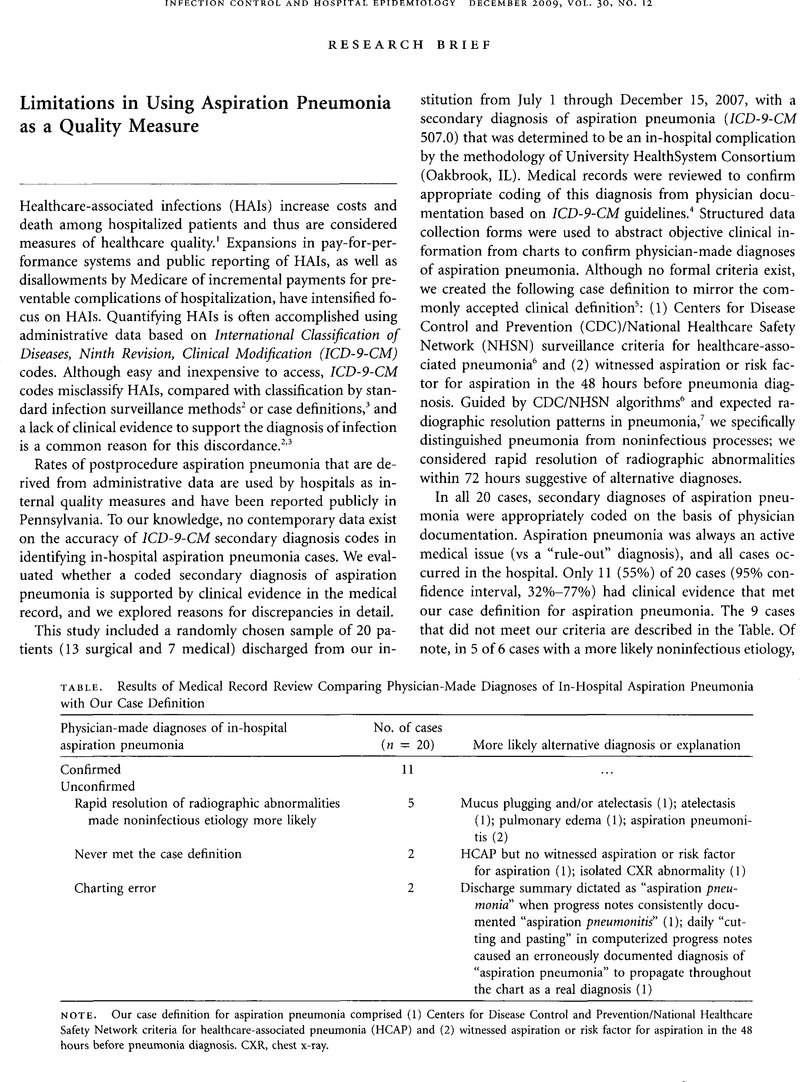No CrossRef data available.
Article contents
Limitations in Using Aspiration Pneumonia as a Quality Measure
Published online by Cambridge University Press: 02 January 2015
Abstract
An abstract is not available for this content so a preview has been provided. Please use the Get access link above for information on how to access this content.

- Type
- Research Brief
- Information
- Copyright
- Copyright © The Society for Healthcare Epidemiology of America 2009
References
1.Burke, JP. Infection control—a problem for patient safety. N Engl J Med 2003;348:651–656.Google Scholar
2.Sherman, ER, Heydon, KH, St John, KH, et al.Administrative data fail to accurately identify cases of healthcare-associated infection. Infect Control Hosp Epidemiol 2006;27:332–337.Google Scholar
3.McCarthy, EP, lezzoni, LI, Davis, RB, et al.Does clinical evidence support ICD-9-CM diagnosis coding of complications? Med Care 2000;38:868–876.Google Scholar
4.Centers for Disease Control and Prevention. 1CD-9-CM classification of diseases, functioning, and disability. 2008. Available at: http://www.cdc.gov/nchs/icd9.htm. Accessed October 19, 2009.Google Scholar
5.Marik, PE. Aspiration pneumonitis and aspiration pneumonia. N Engl J Med 2001;344:665–671.Google Scholar
6.Horan, TC, Andrus, M, Dudeck, MA. CDC/NHSN surveillance definition of healthcare-associated infection and criteria for specific types of infections in the acute care setting. Am J Infect Control 2008;36:309–332.Google Scholar
7.Bruns, AH, Oosterheert, JJ, Prokop, M, et al.Patterns of resolution of chest radiograph abnormalities in adults hospitalized with severe community-acquired pneumonia. Clin Infect Dis 2007;45:983–991.Google Scholar
8.Werner, RM, Asch, DA. The unintended consequences of publicly reporting quality information. JAMA 2005;293:1239–1244.Google Scholar
9.Klompas, M, Platt, R. Ventilator-associated pneumonia—the wrong quality measure for benchmarking. Ann Intern Med 2007;147:803–805.Google Scholar
10.Safdar, N, Maki, DG. The commonality of risk factors for nosocomial colonization and infection with antimicrobial-resistant Staphylococcus aureus, Enterococcus, gram-negative bacilli, Clostridium difficile, and Candida. Ann Intern Med 2002;136:834–844.Google Scholar


